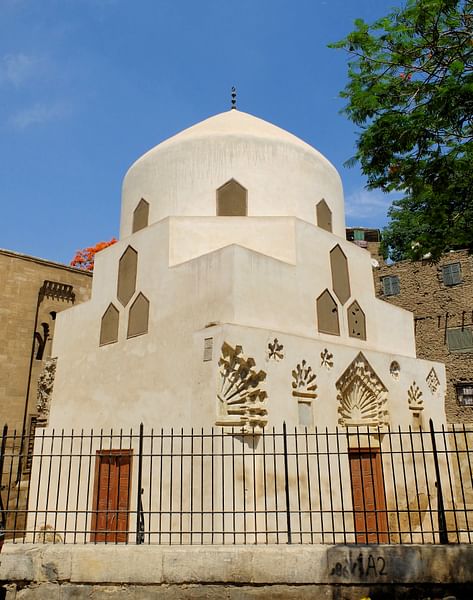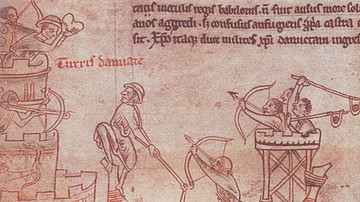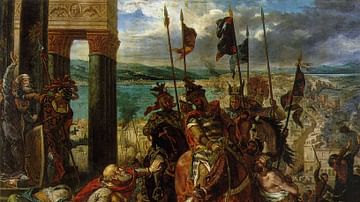
Shajara al-Durr (r. 1250) was the founder of the Mamluk Dynasty in Egypt, and she was the first and only woman to sit on the Islamic Egyptian throne. She held the title of sultana for only 80 days but left a lasting mark through architectural monuments, which bear her symbol: a tree lined with mother of pearl and inlaid with gold.
Early Life
Due to a lack of sources, Shajara al-Durr's date of birth is uncertain; however, some historians speculate that she may have been born not long before 1230 CE, most likely in modern-day Armenia. According to author Emily Fu, "She originally hailed from the Qipchaq (Kipchak) people of the steppes of what is today southern Russia where she was enslaved"(22). Around the time of her birth, Mongols were sweeping across western Asia. As they progressed, the Mongols absorbed some of the Kipchak tribes into their ranks, while dispersing others. Many were taken captive and sold as slaves to the ruling class, such as the Ayyubid Dynasty of Egypt. It was during this time that a young Shajara al-Durr was taken from her land and sold into the harem of the Abbasid caliph.
It is unclear what religion she may have belonged to, but as historian Hossein Kamaly explains, if she was of Armenian background then she would have had a Christian upbringing. However, if she was of Turkic ethnicity, then she would have been Muslim-born. While we know little of her early life, we are certain that in 1239, she resided within the harem of the caliph of Baghdad. Her name shows up among the listings of slave girls in the women's quarters.
At the age of 11, she was transported from Baghdad to either Damascus or Cairo, where she was presented as a gift to the young al-Salih Ayyub (r. 1240 & 1245-9), who was the governor of Hisn Kayfa at the time. A concubine was seen as an appropriate gift for one's allies. However, Shajara al-Durr's life changed after she met the prince.
Marriage to al-Salih Ayyub
Shajara developed an affectionate relationship with al-Salih, and slowly she rose to become his favorite concubine. He granted her the title, Shajara al-Durr, which means "tree of pearls." She even gave birth to a son, but unfortunately, like many children at the time, he died in infancy. At the time, a concubine secured her position by providing heirs for the prince they belonged to. However, fate was about to intervene.
In 1247, al-Salih's cousin wanted to seize the throne of Egypt; upon achieving his goal, he exiled al-Salih to the fortress of Kerak. The prince was accompanied by a handful of companions; we know of two among them: Shajara al-Durr and a Turkic slave called Baibars. Shajara's loyalty and devotion to the prince, especially at this trying time, earned her his love and respect. He went against tradition and married Shajara al-Durr, granting her freedom and the title of queen. Shajara was unable to have any more children, after the death of her son. However, her husband already had an heir from his first wife, so he did not worry about succession.
With the aid of Shajara's Kipchak roots, al-Salih was able to recruit Mamluk (male Kipchak) troops. First, he turned his attention to Egypt, seizing back control, and ensuring the loyalty of all those in his immediate domain.
Crusades
Once al-Salih was back in control, nine turbulent years followed. During this time, al-Salih may have tried to expand the boundaries of his empire. One source claims that he turned his sights to Syria. In hopes of conquering new territory, he marched his army to Syria, leaving Shajara al-Durr to act as regent in his absence. Al-Salih must have had great trust in his queen's abilities; looking after the kingdom was no easy task, especially when news arrived that King Louis IX of France (r. 1226-1270) was fast approaching the Egyptian port, leading the Seventh Crusade. Upon hearing of the French king's arrival, Shajara al-Durr dispatched her husband's top commander, Fakhr al-Din, to hold off the invaders until the king's return. Simultaneously, she dispatched messengers to al-Salih to inform him of the Crusaders' arrival and kept the Crusader army at bay until her husband returned.

In another source, al-Salih never left Egypt after he reclaimed his kingdom because he was ill. His sickness may have been the reason that emboldened the French king to take up arms against Egypt. Whatever the reality may have been, one thing is known for certain, and that is the death of al-Salih in the middle of the conflict. Whether by illness or injury, al-Salih's demise at such a crucial time could have deeply impacted the Egyptian army; however, Shajara al-Durr was determined to secure victory.
She was aware that the Crusaders had already captured important port cities and the news of the king's death would further demoralize the troops. Thus, she kept it hidden for the next three months. She had a doctor visit his tent, food was brought daily, and music played outside the tent. While only a select few loyal allies were aware of the truth, during this time Shajara directed the armies of the sultanate and forged the signature of her husband on decrees. Her effort paid off when Egyptian forces began to repel the Crusaders and eventually captured King Louis.
Shajara al-Durr as Sultana
Once the threat of the Crusaders had subsided, and the news of the king's death began to spread, Shajara al-Durr and her Mamluk advisors invited Turan Shah, her husband's heir, to take the throne. Turan Shah traveled back from Diyarbakir (now in Turkey), and with his wife by his side, they took control of the sultanate. Turan Shah quickly started making disastrous decisions, and he distanced himself from Shajara al-Durr and the Mamluks, who would, in the end, bring about his downfall. The last straw was when Turan tried to threaten Shajara al-Durr and tried to seize her property. Shajara turned to the Mamluks for help, imploring them for their protection. They had witnessed her capabilities as ruler and were happy to replace Turan Shah with Shajara. On 2 May 1250, Turan Shah was assassinated.
In his article Tom Verde quotes 13-century historian Ibn Wasil:
The Mamluks decided that "the functions of Sultan and ruler [of Egypt] should be assumed by Shajarat al-Durr," Ibn Wasil recorded, adding that "decrees were to be issued at her command and … [from] that time she became titular head of the whole state; a royal stamp was issued in her name with the formula 'mother of Khalil,' and the khutba [Friday sermon] was pronounced in her name as Sultana of Cairo and all Egypt."
The khutba is essential to introduce the monarch to his people; the imam (head of the mosque) announces the name of the ruler. In Islamic history, there have been other female monarchs, like Razia Sultana, sultana of Delhi (r. 1236–1240) and others who were not allowed to have the khutba recited for their ascension.
Shajara al-Durr's first act as monarch was to negotiate the ransom of the French King Louis IX and conclude a peace treaty with the Crusaders. Shajara negotiated with her French counterpart, Queen Margaret of Provence (l. 1221-1295), so it can be said that the diplomacy of two queens (one Muslim and one Christian) brought about the end of the Seventh Crusade. Shajara received a huge ransom for Louis IX and started her reign with great triumph, filling the kingdom's coffers.
She issued coins in her name and began construction on her husband's tomb and other architectural projects. Unfortunately, not everyone supported the idea of a female sultan; the caliph of Baghdad refused to recognize Shajara's authority. His refusal created a problem for Shajara and her supporters, and just 80 days into her reign, under threat of revolt, Shajara al-Durr married Izz al-Din Aybak (r. 1250-1257). A condition for this marriage was that Aybak had to divorce his first wife, which he did.
Beginning of the End
While Aybak was the figurehead that represented the Sultanate of Egypt, the true authority remained Shajara al-Durr. The power of decision-making and administrative matters were all handled by Shajara, but Aybak wanted more than the minor role he was forced to play, even quarreling with his wife about the treasure al-Salih had left behind. Many believe that Shajara had hidden the precious riches from Aybak to prevent him from plotting against her.
In 1257, a frustrated Aybak decided to take another bride, in a bid to increase his power in court. He wanted to arrange a political marriage with a princess from Mosul, but his plot was discovered, and his actions were seen as treason. Aybak was moved to the pavilion that overlooked the polo fields, and it was at this pavilion that he was later found murdered. Many believe that Shajara al-Durr may have assassinated her husband because he threatened her authority, but there is no solid evidence to prove who ordered the act.
Death
In the end, Aybak did get his wish; his 15-year-old son, Al-Mansur Ali (r. 1257-1259), took power with the help of the Mamluks. Aybak's assassination diminished Shajara al-Durr's status as she lost the respect of her supporters. Like Mary, Queen of Scots (r. 1542-1567), who may also have had a hand in her husband's murder and was forced to abdicate in favor of her infant son, James I of England, Shajara underestimated how much her nobles were willing to bear, and this mistake cost her her life.
Mansur handed Shajara al-Durr to his mother; she would be the one to pass judgment on the former sultana. Aybak's former wife exacted terrible revenge: Shajara al-Durr was beaten to death by wooden shoes, then her body was dragged by the feet to the top of the citadel and then thrown from the top. Shajara's body was torn apart by dogs before they took pity and buried her remains within the mausoleum she had constructed herself.
The monument is located on al-Khalifa street in Cairo. Inside is a small domed chamber with entrances on three sides. Painted with elegant decorations, the centerpiece of the monument is the glass mosaic conch of the mihrab, which depicts a tree with lined with mother-of-pearl droplets, against a backdrop of gold.
Shajara al-Durr, also known as the "Queen of Pearls," did not rule long, but there is no denying she left a lasting mark on Egypt. A slave girl who went on to become a formidable queen was victorious against the crusaders and founded the Mamluk Dynasty, which would go on to become one of the most powerful in the region. She was the first and only woman to sit on the Islamic Egyptian throne and rule with the support of the Mamluk nobles.









